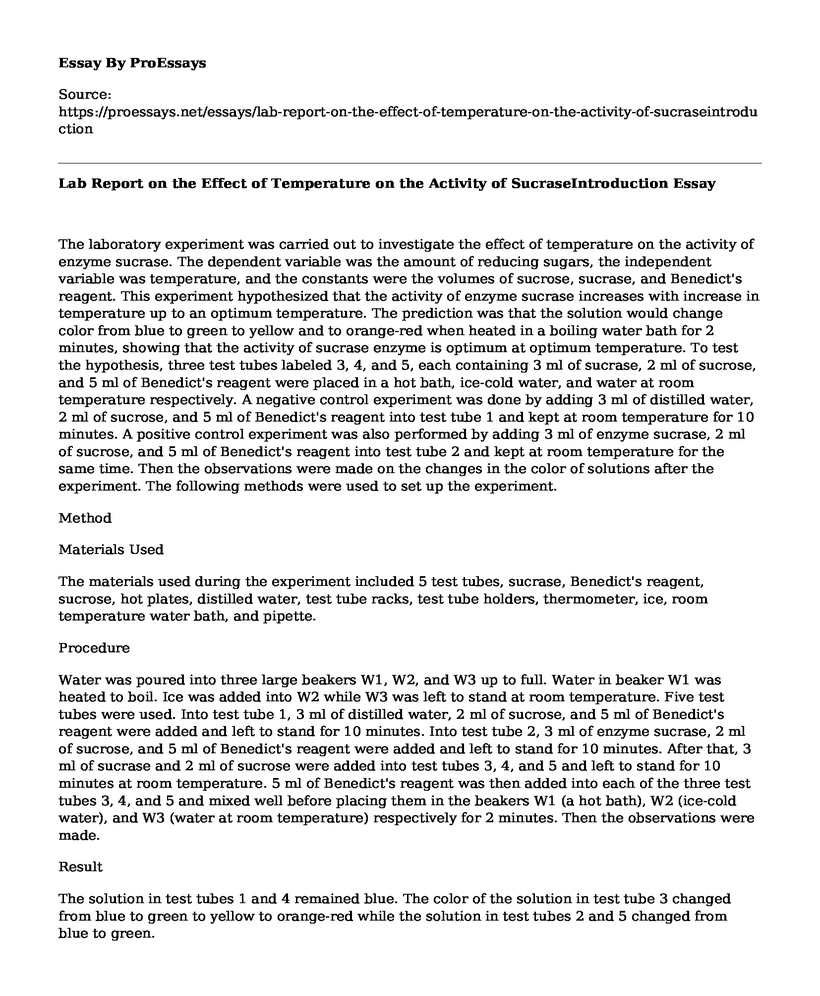The laboratory experiment was carried out to investigate the effect of temperature on the activity of enzyme sucrase. The dependent variable was the amount of reducing sugars, the independent variable was temperature, and the constants were the volumes of sucrose, sucrase, and Benedict's reagent. This experiment hypothesized that the activity of enzyme sucrase increases with increase in temperature up to an optimum temperature. The prediction was that the solution would change color from blue to green to yellow and to orange-red when heated in a boiling water bath for 2 minutes, showing that the activity of sucrase enzyme is optimum at optimum temperature. To test the hypothesis, three test tubes labeled 3, 4, and 5, each containing 3 ml of sucrase, 2 ml of sucrose, and 5 ml of Benedict's reagent were placed in a hot bath, ice-cold water, and water at room temperature respectively. A negative control experiment was done by adding 3 ml of distilled water, 2 ml of sucrose, and 5 ml of Benedict's reagent into test tube 1 and kept at room temperature for 10 minutes. A positive control experiment was also performed by adding 3 ml of enzyme sucrase, 2 ml of sucrose, and 5 ml of Benedict's reagent into test tube 2 and kept at room temperature for the same time. Then the observations were made on the changes in the color of solutions after the experiment. The following methods were used to set up the experiment.
Method
Materials Used
The materials used during the experiment included 5 test tubes, sucrase, Benedict's reagent, sucrose, hot plates, distilled water, test tube racks, test tube holders, thermometer, ice, room temperature water bath, and pipette.
Procedure
Water was poured into three large beakers W1, W2, and W3 up to full. Water in beaker W1 was heated to boil. Ice was added into W2 while W3 was left to stand at room temperature. Five test tubes were used. Into test tube 1, 3 ml of distilled water, 2 ml of sucrose, and 5 ml of Benedict's reagent were added and left to stand for 10 minutes. Into test tube 2, 3 ml of enzyme sucrase, 2 ml of sucrose, and 5 ml of Benedict's reagent were added and left to stand for 10 minutes. After that, 3 ml of sucrase and 2 ml of sucrose were added into test tubes 3, 4, and 5 and left to stand for 10 minutes at room temperature. 5 ml of Benedict's reagent was then added into each of the three test tubes 3, 4, and 5 and mixed well before placing them in the beakers W1 (a hot bath), W2 (ice-cold water), and W3 (water at room temperature) respectively for 2 minutes. Then the observations were made.
Result
The solution in test tubes 1 and 4 remained blue. The color of the solution in test tube 3 changed from blue to green to yellow to orange-red while the solution in test tubes 2 and 5 changed from blue to green.
Discussion
The solution in test tube 1 lacked enzyme sucrase which is responsible for hydrolysis of sucrose; it, therefore, remained blue, maintaining the color of Benedict's reagent. The solution in test tube 4 remained blue because enzyme sucrase was inactive to catalyze the reaction at ice-cold temperature. After 2 minutes, the solution in test tube 3 changed from blue to green to yellow to orange-red indicating a high amount of monosaccharides, fructose, and glucose. It shows that the sucrase was highly active at optimum temperature to convert sucrose into its component monosaccharides, fructose and glucose, which are reducing sugars. Fructose and glucose reduced the copper (II) ions present in Benedict's reagent to the red copper (I) oxide precipitate making the color change from blue to orange-red (Jones et al. 23). The solution in test tubes 2 and 5 changed from blue to green indicating a low presence of monosaccharides, fructose, and glucose, because, at room temperature, enzyme sucrase is less active as compared to optimum temperature.
Conclusion
The experiment confirmed that the activity of enzyme sucrase increases with increase in temperature up to an optimum temperature. For this reason, the hypothesis used in this experiment was confirmed as true. Sucrase enzyme is inactive at ice-cold temperature, moderately active at room temperature, and highly active at the optimum temperature. Therefore, temperature affects the activity of the sucrase enzyme.
Works Cited
Scientific Method Part 1: Experimental Design. Fall 2018.Scientific Method Part 2: Data Collection & Scientific Reporting. Fall 2018.Jones, Mary, et al. Cambridge International AS and A Level Biology Coursebook with CD-ROM. 2014. Retrieved from https://books.google.co.ke/books?isbn=1107636825
Cite this page
Lab Report on the Effect of Temperature on the Activity of SucraseIntroduction. (2022, Nov 28). Retrieved from https://proessays.net/essays/lab-report-on-the-effect-of-temperature-on-the-activity-of-sucraseintroduction
If you are the original author of this essay and no longer wish to have it published on the ProEssays website, please click below to request its removal:
- Incarceration and Transitions to Adulthood among Urban Youth
- Auburn University HR Employee Handbook Information
- Transition From Elementary to Middle School Essay
- Essay Sample on Rehabilitation as a Better Solution Instead of Sending to Prison
- Identification and Evaluation of Normative Leadership Theory Paper Example
- Advanced Technologies & Virtual Supply Chains: Essential for Reducing Global Food Waste - Essay Sample
- Essay Sample on Paul Zahra Revives David Jones: How He Transformed a Struggling Company







